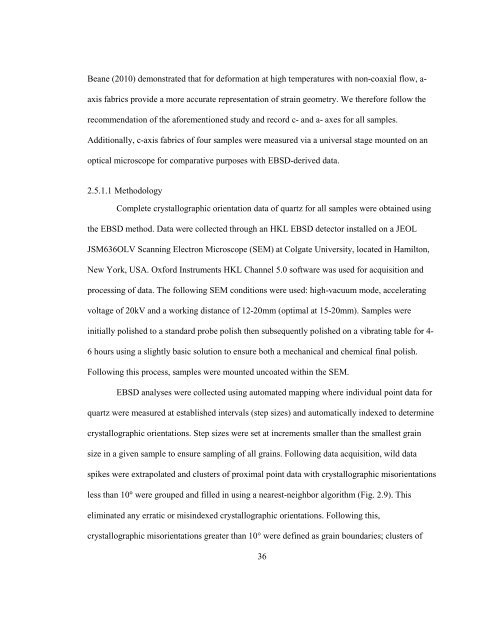title of the thesis - Department of Geology - Queen's University
title of the thesis - Department of Geology - Queen's University
title of the thesis - Department of Geology - Queen's University
Create successful ePaper yourself
Turn your PDF publications into a flip-book with our unique Google optimized e-Paper software.
Beane (2010) demonstrated that for deformation at high temperatures with non-coaxial flow, a-<br />
axis fabrics provide a more accurate representation <strong>of</strong> strain geometry. We <strong>the</strong>refore follow <strong>the</strong><br />
recommendation <strong>of</strong> <strong>the</strong> aforementioned study and record c- and a- axes for all samples.<br />
Additionally, c-axis fabrics <strong>of</strong> four samples were measured via a universal stage mounted on an<br />
optical microscope for comparative purposes with EBSD-derived data.<br />
2.5.1.1 Methodology<br />
Complete crystallographic orientation data <strong>of</strong> quartz for all samples were obtained using<br />
<strong>the</strong> EBSD method. Data were collected through an HKL EBSD detector installed on a JEOL<br />
JSM636OLV Scanning Electron Microscope (SEM) at Colgate <strong>University</strong>, located in Hamilton,<br />
New York, USA. Oxford Instruments HKL Channel 5.0 s<strong>of</strong>tware was used for acquisition and<br />
processing <strong>of</strong> data. The following SEM conditions were used: high-vacuum mode, accelerating<br />
voltage <strong>of</strong> 20kV and a working distance <strong>of</strong> 12-20mm (optimal at 15-20mm). Samples were<br />
initially polished to a standard probe polish <strong>the</strong>n subsequently polished on a vibrating table for 4-<br />
6 hours using a slightly basic solution to ensure both a mechanical and chemical final polish.<br />
Following this process, samples were mounted uncoated within <strong>the</strong> SEM.<br />
EBSD analyses were collected using automated mapping where individual point data for<br />
quartz were measured at established intervals (step sizes) and automatically indexed to determine<br />
crystallographic orientations. Step sizes were set at increments smaller than <strong>the</strong> smallest grain<br />
size in a given sample to ensure sampling <strong>of</strong> all grains. Following data acquisition, wild data<br />
spikes were extrapolated and clusters <strong>of</strong> proximal point data with crystallographic misorientations<br />
less than 10° were grouped and filled in using a nearest-neighbor algorithm (Fig. 2.9). This<br />
eliminated any erratic or misindexed crystallographic orientations. Following this,<br />
crystallographic misorientations greater than 10° were defined as grain boundaries; clusters <strong>of</strong><br />
36

















